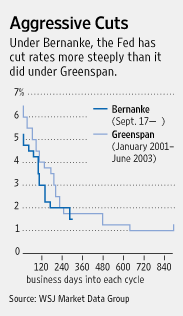Fed Cuts by Three-Quarter Point
By BRIAN BLACKSTONE and HENRY J. PULIZZI
March 18, 2008 2:19 p.m.
WASHINGTON — The Federal Reserve on Tuesday slashed its key interest rate to a three-year low and signaled more reductions are likely, unloading heavy artillery in its effort to keep the credit crunch from triggering a prolonged recession.
The three-quarter-percentage-point rate cut, though extremely aggressive by any historical measure, will disappoint many on Wall Street who thought a full percentage point was needed — a sign of the severity of the crisis that already claimed Bear Stearns and forced Fed officials to use Depression-era tools to create new lending facilities for brokers.
The Federal Open Market Committee voted 8-2 to cut the fed funds rate at which banks lend to each other from 3% to 2.25%, its lowest level since December 2004. The Fed also eased by that amount in a rare intermeeting move two months ago, which was the largest reduction since officials started targeting fed funds in the early 1980s.
Philadelphia Fed President Charles Plosser and Dallas Fed President Richard Fisher dissented, preferring “less aggressive action.”
The Fed also on Tuesday lowered the discount rate it charges banks and brokers that borrow directly from the Fed by 0.75 percentage point to 2.5%, leaving the spread over fed funds at a quarter percentage point.
“Recent information indicates that the outlook for economic activity has weakened further,” the Fed said in a statement, citing weakness in consumer spending and labor markets. “Financial markets remain under considerable stress,” the Fed added, and the “deepening” housing slump should weigh on the economy.
The Fed said growth risks remain and that it will act in a “timely” manner as needed, suggesting more rate cuts are probable barring an economic recovery.
As recently as a few days ago, economists had called for only a half-percentage-point reduction in the fed funds rate. Even that would have been an aggressive move coming just weeks after officials cut the funds rate by 1.25 percentage points over an eight-day period in January.
But as the financial market crisis worsened last week and economic data disappointed, investors steadily upped their rate-cut forecasts to as high as 0.75 percentage point by the end of last week.
And after the Fed on Sunday lowered the discount rate by one-quarter point, extended $30 billion in financing to J.P. Morgan to complete its takeover of Bear Stearns and announced new liquidity measures on top of others that could pump hundreds of billions of dollars into credit markets, many economists concluded that anything less than a full percentage point would disappoint markets and threaten a renewed downward spiral.
Many private-sector economists think the economy is already in a recession, albeit a mild one for the moment as consumer spending has yet to fall and exports remain supportive of overall growth.
But the signs are ominous for what Fed officials call an adverse “feedback loop” in which economic and market difficulties become self-feeding. Housing remains mired in a severe slump, as evidenced by a 16-year low reading Tuesday on homebuilding permits. Back-to-back declines in employment, weak retail sales and a surprisingly large drop in factory output suggest that housing weakness is spreading to other sectors.
Further freeing the Fed’s hand was a surprisingly tame consumer price report last week that showed no change in prices both overall and when food and energy prices were excluded. Inflation will surely rebound this month on the back of record-high oil and gasoline prices. But with the economy slowing, Fed officials expect price pressures to moderate.
“Still, uncertainty about the inflation outlook has increased,” the Fed said, and they will monitor it “carefully.”
The smaller-than-expected rate cut may also signal that officials are growing uneasy about the U.S. dollar’s decline against other major currencies, which has pushed up prices of commodities like oil that are priced in dollars.
A 0.75-percentage-point cut signals “that the Fed does not harbor benign neglect toward the dollar, as has been the impression of late,” said Miller Tabak strategist Tony Crescenzi in a research note before the Fed announcement.

